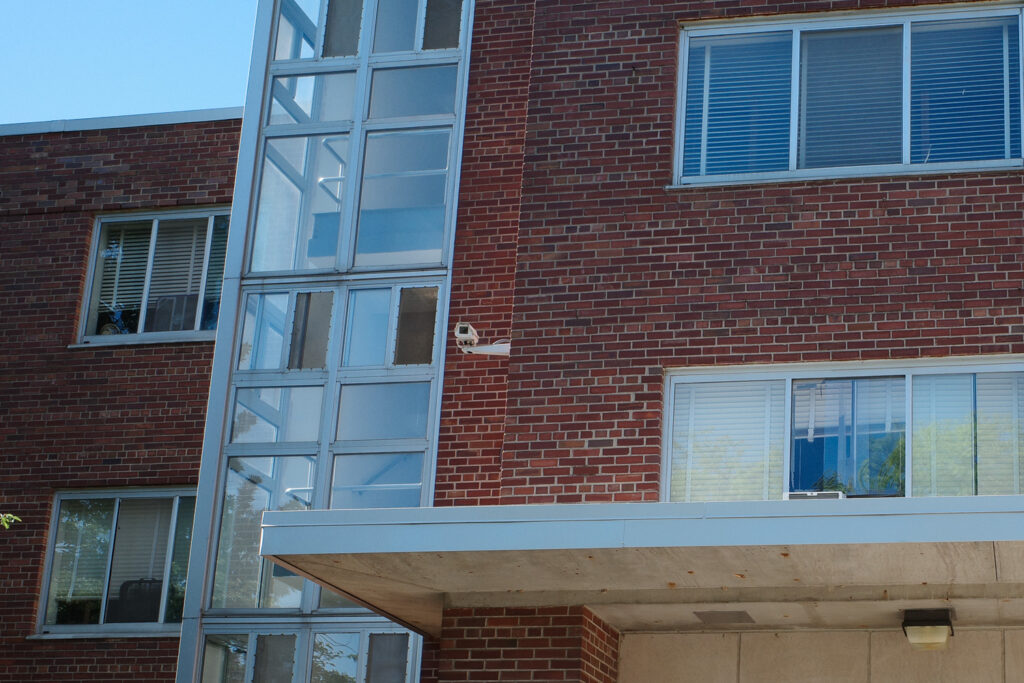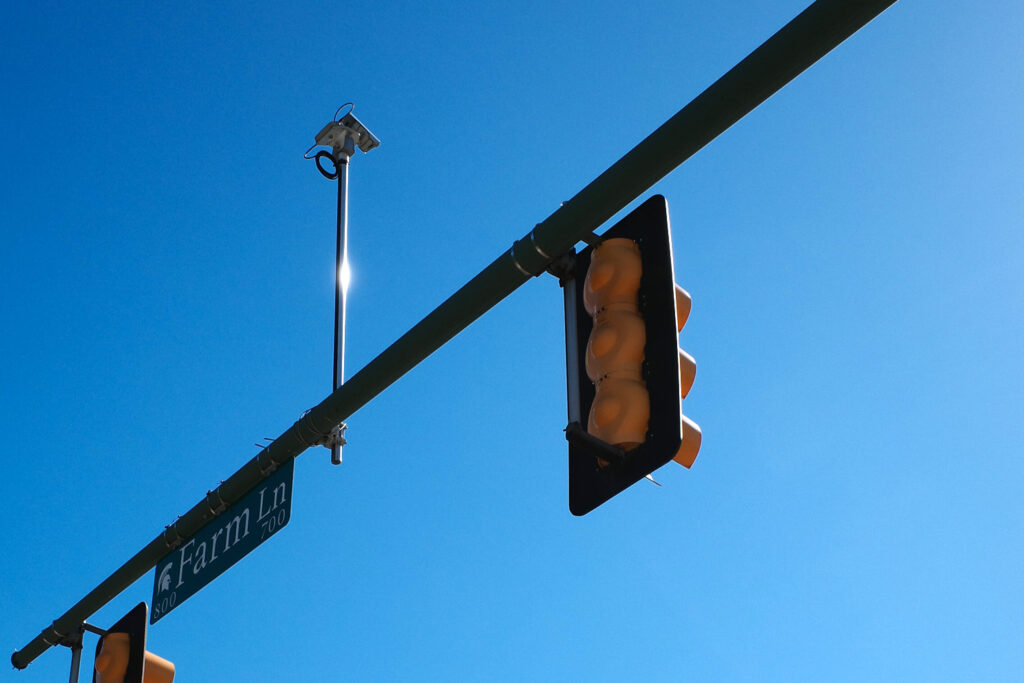East Lansing — In the wake of the shooting on campus last year, when a gunman killed three students and wounded five, Michigan State University has implemented a bold new plan for campus security. It paid a fancy Grand Rapids-based consulting firm, Moss, $10 million to link every one of the 2,000+ cameras and thousands of door sensors on campus via a centralized network, actively monitored by software company Genetec’s AI surveillance suite.
Safetyism meets big-tech horror show. This is the future for MSU students.
Genetec’s AI system will also track vehicle license plates across the entire campus. It will count crowd numbers, distinguishing between adults, children, the elderly, and even handicapped people. It will match ID cards accessing doors with live video footage. The MSU security office hasn’t publicly said it tracks faces, but given the capabilities of similar systems, it’s certainly possible.
The cameras are subtle, but look for them and you’ll see them everywhere. Above every traffic light, exterior doorway, sidewalk, and alley. They’re on the “green light” telephones scattered around campus, with their little phones direct to campus police. What do you think gets more use, the green-light phones themselves or the cameras above them?

All of the camera data now feeds into the new centralized security center. This is the real upgrade. The cameras aren’t new, the data isn’t new. What’s new is the detailed monitoring, the AI aggregation, and analysis. You’re not just monitored on campus now—you’re tracked.
This is a major difference. A live feed of cameras, with security guards monitoring them, exists only in the moment. AI data collection, active tracking of all campus personnel, logging of every license plate for every vehicle that traverses the campus, is an entirely new move. Your movements across campus are now, in effect, part of a massive university study, the omnipresent eyes of the institution analyzing it all.
Dana Whyte, a spokesperson for MSU Police and Public Safety, described one example of its capabilities: “If there is a door propped open, an alarm would go off in the security operations center and a camera would automatically turn to where that door is.” She further stated the system will operate 24 hours a day, with full-time staff monitoring all cameras, doors, and access points aggregated through the AI system.

What do you think they’ll find? A surprising number of freshmen sneaking out of their dorms late at night to smoke weed, no doubt. Couples leaving empty corners of the library suspiciously late at night. I wonder if the AI can recognize a bong—they’d have nailed my college buddies who may or may not have smoked one on the University of Michigan diag the night before graduation. As one student pointed out on reddit, “Consider the likelihood of each of those things. How many parking tickets get written every day? How many shooters have there been in the history of the campus? How many students have gotten their lives messed up by getting caught with a joint or a beer?”
They’ll definitely find more ways to issue parking tickets. MSU issued nearly 100,000 parking tickets already last year using a system mounted on parking-enforcement vehicles that automatically scans license plates on parked cars, tagging them for parking violations. This tracking regime already caused an uproar among the student body, with one student even designing an app called “TicketTime,” where students can report the presence of meter maids to others.
Of course, the security regime won’t say parking tickets are the goal, and they certainly won’t say this whole endeavor is to catch freshmen smoking weed. But we all know what happens with absolute power—it corrupts. If every door opening on campus can be tracked, if every movement can have a camera turned on it, that data can be leveraged against anyone. It starts to really matter who’s in charge.
Students don’t sign a user agreement, like when they download a new app. There’s no option to opt out from the camera system blanketing the whole campus. Hell, you don’t even need to enroll. Just drive through or step foot on campus and your movement is recorded. Could this data be used for other sorts of research, or even sold?
Critics have been quick to point out that this all does little, in the event of another crisis, to actually increase response time. They say it’s security theater, like the TSA still making everyone take their shoes off 20 years after the “shoe bomber.”
The critics miss the bigger picture, however, because this is more than just a development of security policy. It’s another manifestation of the university system’s schoolmarm, safetyist mentality, and its warped view of its own students as cattle to be zapped into submission.

Supposedly, the goal of a university is to educate its students. Their tuition funds faculty salaries and research. It’s a mutual deal, a compact. One hand washes the other. But decades ago, the compact was broken. Universities grow more selective, tuition rises, and faculty are sidelined in favor of increasing administrative bloat. Students don’t have the bargaining power they used to. The managers have seized control, and who manages the managers?
Through the eyes of these managers, many of whom couldn’t even get into the school they manage, the students are mere customers. Pay pigs. Sheep to be shorn. Keep the money flowing in, most of it funneling straight from the federal government through the ghostly bodies of these forlorn scholars, and all will be well.
Undoubtedly, the university will tolerate a little youthful rebellion just to keep the money flowing. But what happens when they decide, ultimately, that students have gone too far? It will be rather easy, with this new data, to build models of the social environment on campus. To pinpoint who, precisely, the troublemakers are. No need to search them out, every ID card swipe builds a grand picture of the scene.
Given the recent campus protests over a certain war in the Middle East, the more left-leaning student activist groups are frightened and are speaking out against AI tracking. Campus administrations were quick to crack down on the protests using various forms of bureaucratic trickery.

“American universities, which should have been the palladiums of the West, have become radicalization centers that pit students against them,” wrote my colleague Mitch Miller in his piece describing the campus dynamics behind the protests. The universities radicalize their students and then cry out when the students rebel. It’s only a matter of time where the new security regime becomes a tool to clamp down on the unfortunate dynamic that they themselves have fostered.
If the frat bros knew what was going on, they’d say something too. This could easily become another tool in the toolshed for the growing crackdown against greek life nationwide. They already tried to ban them at Harvard in 2017 by sanctioning students who joined single-sex organizations, but they were forced to drop the policy after a lawsuit. They can’t ban fraternities, or partying, or youthful rebellion outright, so they’ll use managerial tricks and surveillance. This isn’t just a threat to speech, it’s a threat to fun.
A specter now hangs over every Sunday morning walk of shame. Even if it doesn’t interfere, it is present. The act of watching and being watched, being actively tracked, changes the social environment irreparably. If these managers ever actually did the reading, they’d know this: The panopticon is a prison, a dystopia. The act of observation changes behavior even if the prisoners can’t see the guards looking at them. It violates whatever remains of the compact between the university and its students.
Students go to learn, and to live, and to learn from living—they have to be allowed to do so, or the college dream falls apart. Keep pushing them, prodding them, tracking them, and watch just the institution crumble.
Bobby Mars is an artist, alter ego, and former art professor. Follow him on X at @bobby_on_mars.



